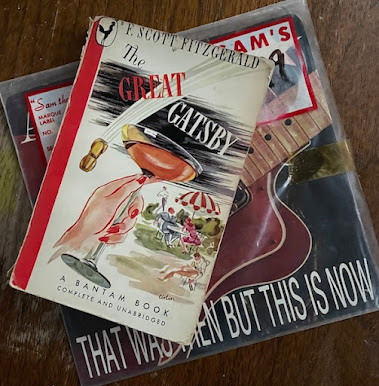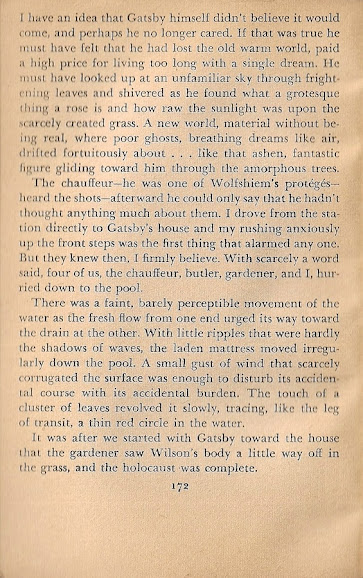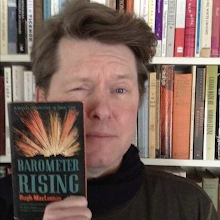Thomas D'Arcy McGee13 April 1825, Carlingford, County Louth, Ireland7 April 1868, Ottawa, Ontario, CanadaRIP
13 April 2025
Thomas D'Arcy McGee: 200 Years
10 April 2025
The Great Gatsby: 100 years
I was on my lunch break when I first read of Jay Gatsby's death. This was in the back room of the Rockland Centre Sam the Record Man. Twenty-one, I was in charge of the singles department.
The description, as imagined by Nick, is so subtle that the tragedy passed without me seeing it. In my old Bantam edition it begins and ends on a single page. I returned to the beginning because I couldn't quite believe it.
I write about Canadian literature. The Great Gatsby is not a Canadian novel, but it but it is my favourite novel.
On this, the one hundredth anniversary of its publication, it is only right to recognize it.CanCon I:
About this time an ambitious young reporter from New York arrived one morning at Gatsby's door and asked him if he had anything to say."Anything to say about what?" inquired Gatsby politely."Why,—any statement to give out." It transpired after a confused five minutes that the man had heard Gatsby's name around his office in a connection which he either wouldn't reveal or didn't fully understand. This was his day off and with laudable initiative he had hurried out "to see."It was a random shot, and yet the reporter's instinct was right. Gatsby's notoriety, spread about by the hundreds who had accepted his hospitality and so become authorities on his past, had increased all summer until he fell just short of being news. Contemporary legends such as the "underground pipe-line to Canada" attached themselves to him, and there was one persistent story that he didn't live in a house at all, but in a boat that looked like a house and was moved secretly up and down the Long Island shore. Just why these inventions were a source of satisfaction to James Gatz of North Dakota, isn't easy to say.
His house had never seemed so enormous to me as it did that night when we hunted through the great rooms for cigarettes. We pushed aside curtains that were like pavilions and felt over innumerable feet of dark wall for electric light switches—once I tumbled with a sort of splash upon the keys of a ghostly piano. There was an inexplicable amount of dust everywhere and the rooms were musty as though they hadn't been aired for many days. I found the humidor on an unfamiliar table with two stale dry cigarettes inside. Throwing open the French windows of the drawing-room we sat smoking out into the darkness."You ought to go away," I said. "It's pretty certain they'll trace your car.""Go away now, old sport?""Go to Atlantic City for a week, or up to Montreal."
01 April 2025
I didn't realise that you wrote poetry. I didn't realise you wrote such bloody awful poetry
Say what you will about Satan, he's no dummy.
I think I'm right about this, but am not sure.
He had no place in my family's place of worship. I never once heard mention of the Prince of Darkness in church school, confirmation class or even a sermon. This could have something to do with having been raised Anglican.
I am not sure.
My early reading on Satan was extremely limited. It began in October 1974 with 'The Ecchorcist,' MAD magazine's parody of The Exorcist, continued with Joy Carroll's horror romance Satan's Bell (1976), and more or less ended with novelizations of the films The Omen (1976) and Damien:The Omen II (1978).
No one I've read thus far had more to say about Satan and what he's up to than the late televangelist John Wesley White – author of Re-entry (1970), The Man from Krypton (1978), Arming for Armageddon (1983), and Thinking the Unthinkable (1992) – though I'm not sure how much he can be believed. I very much doubt that this song is intended to bring the listener to love Satan, as Dr White claims:
I may be wrong.
From everything I've read, Satan is cunning, creative, devious, and extremely intelligent. What he isn't is a good poet.
I can say this with certainty having browsed Michelle Remembers, the 1980 bestseller credited with providing the spark for the Satanic Panic. I'm planning on writing about it later this year, but for now, this being the first day of National Poetry Month, I thought it might be appropriate to share one of the many samples of Satan's verse recorded in the book by authors Michelle Smith and Lawrence Pazder:
If you say one word I say to you,
You'll say it all until it's through.
You'll run out of time, run out of space,
Run at the mouth all over the place.
You can only go inside your head,
And if you go there, then you're dead.So you see, I've turned it inside out;I've turned you around, turned you about,You always come back to me,The only way out is to see through me.The more goes out, the more comes in,You'll start to end when you begin.
So begins a theological debate. Is there something lacking in the Prince of Darkness – a heart, perhaps – that prevents him from being anything other than a rotten poet or is his verse intentionally bad so as to bring hell on Earth?
Frankly, I'm beginning to have doubts that Satan composed any of the poems in Michelle Remembers.
My thanks to fellow CanLit scholar Brad Middleton, who generously donated two copies of Michelle Remembers to The Dusty Bookcase.
24 March 2025
Joyce Boyle: Early Research
Emily Joyce Boyle was born on April 6, 1901, missing that year's census by a matter of days. The 1911 census finds Joyce as a ten-year-old living at 227 Westminster Avenue in Toronto with her mother Charlotte and three surviving siblings (Gertrude, John, and Beatrice). Her father, William, recorded in previous censuses as lumber merchant and a crockery merchant, died when she was a four-year-old.
At the time of the 1921 census, Joyce was still living on Westminster Avenue with her mother, Gertrude, and Beatrice. Interestingly, all four Boyle women are reported as having no occupation. They were certainly not members of the leisure class, yet the family appears to have had the means to send Beatrice and Joyce off to the University of Toronto.
The photo of Joyce Boyle featured above, the only one I've found, comes from the 1924 edition of Torontonesis, the university's student annual. These are the words that appear below:
In the 1931 census, thirty-year-old Joyce and forty-six-year-old sister Gertrude are listed as living at 307 Castlefield Avenue in Toronto. Joyce's occupation is school teacher, while Gertrude's is school librarian.
 |
| 307 Castlefield Avenue in June 2021 |
The previous year, Joyce had published Mary, John and Peter, which is most likely her first book.
 |
| Toronto: T. Eaton, 1930 |
Intriguingly, Joyce Boyle's entry in the Database of Canada's Early Women Writers notes that McMaster University's Macmillan Company of Canada Archives contains correspondence regarding an earlier work, Spring Blew Around the Corner, of which there is no known copy. Was it ever published? Thus far, I've found no reviews, adverts or even passing mentions in newspapers and magazines.
She's credited with eleven other titles, most of which – Mary, John and Peter being one – are schoolbooks meant for young children. Of those that aren't, the one that garnered the greatest attention was Muskoka Holiday, a 1953 girls' adventure novel published by Macmillan in Canada, England, and the United States.
Muskoka Holiday has my favourite cover by far, though Bobby's Neighbors has a certain lazy charm.
 |
| Nashville: Abingdon, 1959 |
Joyce Boyle died at the age of seventy-four on June 7, 1975, at Women's College Hospital in Toronto. She was predeceased by all of her siblings (including previously unmentioned Ernest, who died on the date of his birth, and Edith, who died at eleven). The University of Toronto's Joyce Boyle Scholarship is awarded to "a student with overall A standing who is enrolled in the Specialist or Major program in English, with preference to a student whose courses have included romantic poetry or prose." It was established by brother-in-law Stephen James Mathers (1896-1985), who was married to Joyce's sister Beatrice (1899-1969). Mathers also established a scholarship in honour of his late wife.
A good man.
From all I've been able to glean from newspaper articles, Joyce Boyle was a woman who dedicated her life to children's education. She was particularly focussed in fostering early interest in literature and the cause of world peace.
A good woman.
22 March 2025
Tumbling Towards Mystery
Joyce Boyle
Toronto: Macmillan, 1961
151 pages
A big city girl made unhappy by her family's move to a small town, sixteen-year-old Isobel Anderson will be a familiar figure to readers of children's fiction. In her case, the big city is Toronto; the small town is Farston, to which Isabel's father (occupation unknown) has been transferred.
Coinciding with Farston High School's Christmas break, the Andersons' arrival is soon followed by a different sort of break. One particularly blowy, snowy day, Isobel is out on a solitary a walk when she falls and does something to her foot. Isobel tries to make for home, but the pain is too great. It's all she can do to reach the nearest dwelling, an old stone cottage that sits high on the hill at the end of her road. No one responds to her knocking, but she finds the door unlocked. And that is where she is found sometime later by young Eleanor Morgan. The girl lights a fire, makes sure Isobel is comfortable, and then sets off to get help. This arrives in in the form of a sleigh driven by Doctor Gordon Brown – "I'm Doctor Gordon Brown" – who then whisks her off to hospital where "several small foot bones" are found to be broken.
Forget the foot, this mystery concerns a stone cottage. Built by Eleanor's great-great-great grandfather, the building is now owned by the town, which has handed it over as the meeting place of the Farnston High School Historical Club.
Two observations:
- at my high school, clubs met in the school itself;
- there was always a teacher present, which is never the case here.
Isobel's date, Eleanor's brother John, proves a true gentleman:
"Good time?" he asked.And off he goes home.
"Never better," was Isobel's answer. "Oh, John, it was a perfect evening! And all I can say is 'Thank you'!"
"That's all you need to say," was John's reply. "Thats all you need to say when you use that tone of voice."
 |
| The Edmonton Journal, 10 September 1958 |
As expected, Isobel, Eleanor, and their schoolmates solve the mystery of the missing money and papers. That they do this with the assistance of Miss Malcolm (Isobel's Toronto history teacher), Miss Norman (Isobel's Farston history teacher), and Miss Fleming (the town librarian), raised a smile because Joyce Boyle herself was a teacher and librarian.
She never married.
I know more about her than I do my great-great-great-grandparents or even my great-great-grandparents.

















